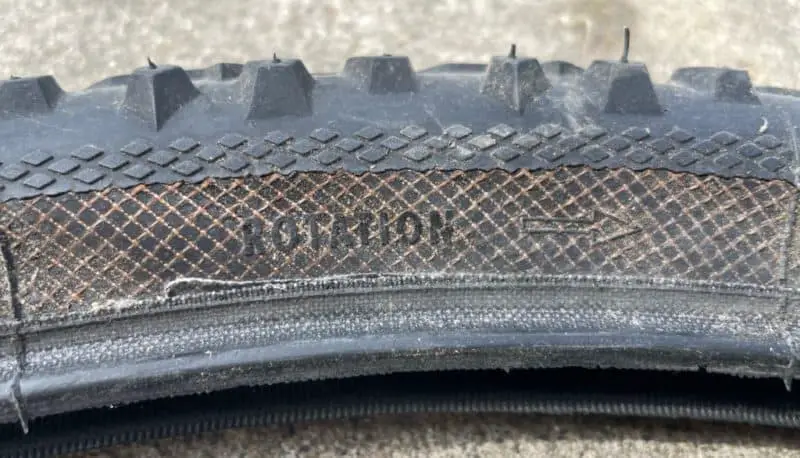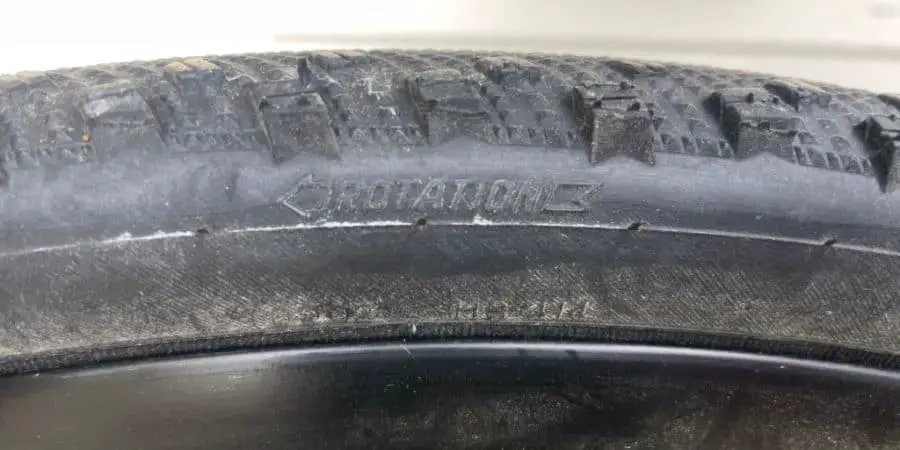
Tires, the essential contact point of our bikes, require extra thought. One of the big questions for new riders is whether or not their tires need to be faced in a certain direction.
So, do bike tires have a direction?
Most bike tires are directional. The sidewall will usually have a marking which indicates the direction the tire should face. For example, an arrow that points in the direction of the tire’s intended rotation. For some types of bikes, the rear and front tire will also face in opposite directions for optimal performance.
Making sure your tires are oriented properly is easy enough, so let’s dive into the how and why of bike tire directions.
We’re going to answer the following questions:
Can You Put a Bike Tire on Backwards?
As a general rule, it is possible to put bike tires on backwards. This is a common mistake, especially for people who are inexperienced with bike maintenance. But you should avoid installing a bike tire backwards, because a backwards tire can negatively affect the performance and safety of your bike.
Personally, I’ve made this mistake several times. I’ve done a lot of riding on road bikes, which have very flat (minimal tread) tires, and when you go to put them back on, you really need to check the side wall of the tire for the direction indicator, otherwise you might end up getting the direction wrong if you’re just eye-balling it.
That said, getting the direction wrong isn’t just a road bike problem. In fact, it’s probably even more important to get the direction right on bike’s that have more tread (like hybrid, or mountain bikes).
How To Tell Which Way Your Bike Tread Should Go
There are a few different ways you can figure out the proper tread direction for your tire. Try the following if you’re not sure.

Use the Direction / Rotation Arrow on the Side Wall
Most directional bike tires have arrows that indicate which way they should face. So, the easiest way to tell if you have your tire tread facing the correct direction, is to look for an arrow on the side of the tire that points in the direction of the tire’s rotation.
Where some people get confused is the front/rear designation on the tires.
Different bikes may have tread facing in different directions for the front and back tire. For instance, off road bikes often have the tread for the rear and front wheels pointing different directions. On the other hand, road bike tires usually use tread that points/rotates in the same direction.
So, if your tires have front/rear designations printed on the sidewall, that is telling you the direction the tire should face when installed in each location (front or rear).
Examine the Tread Pattern
If your tire doesn’t have any indication on the sidewall, you can look at the tread itself.
You’d look for something like chevrons in the center of the tire. In some cases, you may also have a ramped leading edge which helps point the way. The ramped edge tread will “bite” for more traction.
It’s relatively easy to figure out the direction for some tires, especially those that have a tread design that clearly “points” in the direction of the wheel’s rotation. However, in other cases it may be more difficult. For example, there might be very little tread (like with skinny road bike tires), the tread might not have a clear direction, or you may not be sure whether both tires should be facing the same way (or be reversed) for your specific bike model.
If you run into any of those scenarios, and you’re not sure what way to put your tire on, then you may be able to use this next approach instead.
Check the Other Tire (Or One That is Already Installed Correctly)
If you already have one tire installed of the same type, and you know it was done correctly, you can use it as a guide.
A quick Google Image search can also turn up the right orientation if you know the model of the tire. Just put in the model number and see if you can find instructions from the manufacturer for how it should be oriented on the wheel.
And if all else fails, and you’re still not confident that you will get your bike tire pointing in the right direction, you can always consult a mechanic at a local bike shop to be safe.
Does Tire Tread Direction Matter for Bikes?
Tread direction can make a big difference for off-road use, but tires designed for the road will see less of a difference when they’re oriented in the wrong way.
Mountain Bike Tread Orientation
Mountain bike treads usually run in the opposite way between the front and rear tire. The forward-facing chevrons grip better, allowing the front wheel to maneuver in tight spots.
The increased friction on the rear tread allows for better power transfer when you’re pedaling in soft terrain. You’ll appreciate it riding dirt or sand trails, where slipping tires results in wasted effort. You lower your pressure on soft materials for the same reason, the blocked tire edge just gives it a little more push in the right direction.
It works especially well with tires that have both a sloped and blocked edge. The blocked edge gives a lot of “bite.”
This increased rolling resistance is great on dirt, but it takes more effort to ride when you’re on pavement and concrete. If you’ll only be using the bike in town you may want to run both tires facing the same direction. That said, it may be better to leave them as-is and just increase the tire pressure for better riding in town.
What you don’t want to do is reverse the front tire of your mountain bike. It will make it harder to brake, and it can also cause a loss of traction when cornering. That’s irritating at best, and asking for a wreck at worst.
Orientation matters the most when you’re riding off-road, so follow the manufacturer’s instructions when you’re getting your bike set up.
Road Bike Tire Orientation
Road bike tires are built to make as little contact with the ground as possible and the tread direction doesn’t matter as much for riding purposes.
The tires often have an orientation indicated just to save time for the person working on the bike. People will look at the tire for orientation so it works better to have a label there, but they’re often unnecessary.
Some road bike tires are designed to make riding through puddles easier and avoid hydroplaning. They’ll often have channeled grooves designed to shunt the water away.
In that case, it’s best to go with the orientation that’s indicated. In either case, you’re not likely to see a performance drop because your slicks are on backward.
The characteristics of road bike tires, being narrow and using high-PSI, make the tread on the tire mostly cosmetic. Most riders will just stick with the indicated direction.
In fact, I’ve accidentally ridden my road bike with the incorrect tire orientation, and didn’t really notice any difference in performance. With that said, you obviously shouldn’t do this on purpose, and you should be intentional about following the manufacturer’s recommendations.
